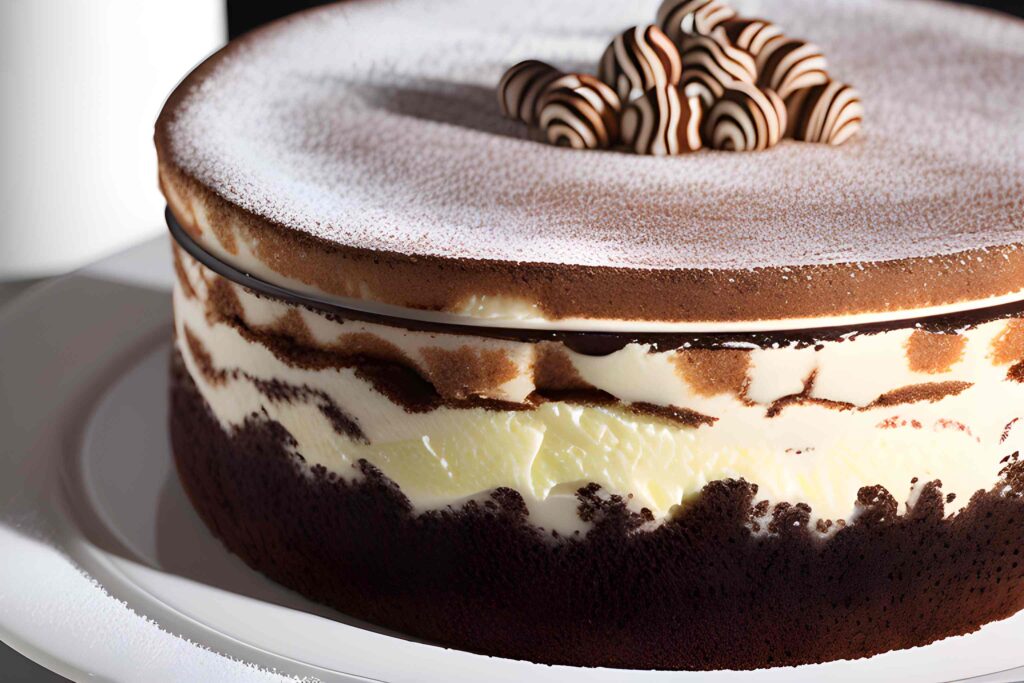This post may contain affiliate links which means I may receive a commission for purchases made through links.

Table of Contents
Audio stream for this article
Introduction
Tiramisu, a classic Italian dessert, is renowned for its irresistible combination of rich flavors and luscious, creamy texture. Originating from the Veneto region of Italy, this beloved dessert has gained immense popularity worldwide and has found a place in the hearts and homes of dessert enthusiasts everywhere.
With its name translating to “pick me up” or “lift me up” in Italian, it lives up to its reputation as a mood-lifter and a true indulgence. This delectable dessert has become a staple on menus in Italian restaurants and has even made its way into home kitchens, where families and friends gather to relish its heavenly taste.
The allure of the dessert lies in its harmonious combination of contrasting elements. Layers of delicate ladyfingers, soaked in a coffee-based mixture, alternate with a velvety mascarpone cream, creating a symphony of flavors and textures that is sure to captivate the senses. Its signature dusting of cocoa powder adds a touch of bitterness, balancing the sweetness and adding a visual appeal to the final presentation.
One of the reasons for its’s widespread popularity is its versatility. While the traditional recipe remains cherished, variations have emerged over time to cater to diverse tastes. From fruit-infused versions to chocolate-inspired renditions, there is a variation to suit every palate. Furthermore, it is also possible to adapt it to specific dietary requirements, such as gluten-free or vegan, allowing more people to enjoy this delightful dessert.
Whether enjoyed after a hearty Italian meal or as a standalone treat, it holds a special place in the hearts of dessert enthusiasts around the globe. Its decadent flavors, creamy texture, and the hint of coffee offer a delightful escape into a world of culinary delight. By mastering the art of creating tiramisu from scratch, you can bring the magic of this Italian masterpiece to your own kitchen and create unforgettable moments of indulgence for yourself and your loved ones. In the following sections, we will explore the history, ingredients, step-by-step preparation, serving suggestions, and variations of this exquisite dessert.
The History and Origin of Tiramisu:
The dessert that has become an icon of Italian cuisine, can be traced back to the picturesque region of Veneto in northeastern Italy. While the exact origins remain a topic of debate and mystery, several theories have emerged, each contributing to the rich history and allure of this beloved dessert.
One popular theory suggests that it was born in the 17th century in the city of Treviso, located in the Veneto region. It is believed to have been created as a variation of a traditional dessert called “Zuppa Inglese,” which translates to “English Soup.” This sweet dish consisted of layers of ladyfingers soaked in liqueur and custard.
Another theory suggests that it originated in the city of Siena, located in Tuscany. According to this theory, the dessert was created as a celebratory treat during the visit of Grand Duke Cosimo III de’ Medici to the region in the late 17th century. The dessert was said to have been made with coffee and chocolate, which were novelty ingredients at the time.
The meaning behind the name “tiramisu” is also a subject of speculation. One theory suggests that it stems from the phrase “tira mi su,” which translates to “pull me up” or “lift me up” in Italian. This name could be attributed to the energizing and uplifting qualities of the dessert, thanks to the combination of coffee and sugar.
Over the years, chefs and home cooks have experimented with tiramisu, introducing variations and adding personal touches to the classic recipe. Today, one can find a myriad of creative twists on this iconic dessert, including fruit-infused tiramisu with berries or citrus, chocolate-infused versions with layers of ganache or Nutella, and even savory adaptations using ingredients like matcha or pistachio.
In conclusion, tiramisu’s history and origin are still shrouded in mystery, but its undeniable allure and widespread popularity have made it a beloved dessert around the world. The combination of flavors, textures, and its uplifting nature have ensured that it continues to be cherished and celebrated. Its evolution and the countless variations available today are a testament to the enduring appeal of this Italian masterpiece.
Ingredients Needed:
To create a delectable tiramisu, you will need the following ingredients:
1. Ladyfingers (Savoiardi): Approximately 24-30 pieces
2. Strong brewed coffee or espresso: 1 ½ cups (360 ml)
3. Coffee liqueur (optional): 2-3 tablespoons (30-45 ml)
4. Eggs: 4 large, separated into yolks and whites
5. Granulated sugar: ½ cup (100 g), divided
6. Mascarpone cheese: 16 ounces (450 g)
7. Heavy cream (whipping cream): 1 cup (240 ml)
8. Vanilla extract: 1 teaspoon (5 ml)
9. Unsweetened cocoa powder: For dusting on top
10. Pinch of salt
Kitchen materials and equipment needed:
1. Mixing bowls: You’ll need separate bowls for beating egg yolks, egg whites, and whipping cream.
2. Whisk or electric mixer: To beat the egg yolks, egg whites, and whipping cream to the desired consistency.
3. Spatula: For folding the mascarpone cheese into the whipped cream.
4. Deep rectangular dish: Ideally, choose a dish that can accommodate multiple layers of ladyfingers and cream.
5. Plastic wrap or aluminum foil: To cover and refrigerate the tiramisu.
6. Sifter or fine-mesh sieve: For dusting cocoa powder on top of the final layer.
7. Electric or stovetop espresso maker: If using espresso instead of coffee.
Importance of using high-quality ingredients
Using high-quality ingredients is crucial for achieving the best results in tiramisu. Here’s why:
Ladyfingers: choose for authentic Italian ladyfingers (Savoiardi) as they have the ideal texture and flavor for tiramisu. Look for brands that use quality ingredients and avoid ones that are overly dry or lacking in flavor.
Coffee or espresso: Choose a high-quality coffee or espresso for the soaking liquid, as it will significantly impact the overall flavor. Freshly brewed coffee or espresso provides the best taste, but if necessary, you can also use instant coffee or decaffeinated options.
Mascarpone cheese: Select a good-quality mascarpone cheese, preferably from an Italian brand. It should have a rich, creamy consistency and a mild, slightly sweet flavor. Avoid mascarpone that is grainy or excessively sour.
Eggs: Use fresh eggs from a reliable source to ensure the best flavor and texture. If concerned about consuming raw eggs, choose pasteurized eggs or consider using a suitable egg substitute.
Cocoa powder: Use unsweetened cocoa powder of good quality to achieve a balanced and rich chocolate flavor. Dutch-processed cocoa powder can also be used for a darker and deeper chocolate taste.
Possible substitutions or variations:
While the classic tiramisu recipe is delightful on its own, you can experiment with substitutions or variations to suit your preferences:
Alcohol
Coffee liqueur is traditionally used in tiramisu, but you can substitute it with other liqueurs like amaretto, rum, or marsala wine for different flavor profiles. For a non-alcoholic version, skip the liqueur altogether and increase the coffee amount.
Sweeteners
If desired, you can use alternative sweeteners like honey, maple syrup, or powdered sugar in place of granulated sugar. Adjust the quantity to taste.
Flavorings
Enhance the flavor of your tiramisu by adding a hint of almond extract, orange zest, or a sprinkle of cinnamon to the mascarpone cream.
Ladyfinger alternatives
Experiment with different types of biscuits or sponge cakes as a substitute for ladyfingers. Biscotti or sponge fingers can be used, but keep in mind that the texture and soaking time may vary. Remember, while substitutions and variations can be fun, they may alter the traditional taste and texture of the tiramisu. Feel free to get creative, but also appreciate the beauty of the classic recipe.
Step-by-Step Preparation
Preparing the Mascarpone Cream
Ingredients
4 large eggs, separated
½ cup (100 g) granulated sugar, divided
16 ounces (450 g) mascarpone cheese
1 cup (240 ml) heavy cream (whipping cream)
1 teaspoon (5 ml) vanilla extract
Pinch of salt
Instructions
In a large mixing bowl, whisk the egg yolks with ¼ cup (50 g) of granulated sugar until the mixture becomes pale and creamy.
Add the mascarpone cheese to the bowl and gently fold it into the egg yolk mixture until well combined. Set aside.
In another mixing bowl, beat the egg whites with a pinch of salt until soft peaks form.
Gradually add the remaining ¼ cup (50 g) of granulated sugar to the egg whites while continuing to beat until stiff peaks form.
In a separate bowl, whip the heavy cream until it reaches the consistency of soft peaks.
Gently fold the whipped cream into the mascarpone mixture.
Finally, fold in the beaten egg whites, taking care not to overmix. This will help achieve a light and airy texture for the mascarpone cream. Set aside.
Soaking the Ladyfingers
Ingredients
Approximately 24-30 ladyfingers (Savoiardi)
1 ½ cups (360 ml) strong brewed coffee or espresso
2-3 tablespoons (30-45 ml) coffee liqueur (optional)
Instructions
Brew a strong cup of coffee or prepare espresso using your preferred method. Allow it to cool to room temperature.
If using coffee liqueur, stir it into the cooled coffee or espresso. Set aside.
Take each ladyfinger and quickly dip it into the coffee mixture, ensuring both sides are evenly soaked. Be careful not to oversoak the ladyfingers, as they can become too mushy.
Place the soaked ladyfingers in a single layer at the bottom of a deep rectangular dish. Repeat until the entire bottom is covered.
Note that the soaking time can vary depending on the brand and texture of the ladyfingers. Aim for a moist but still slightly firm consistency. Adjust the soaking time accordingly.
By following these steps, you will create a delicate and flavorful mascarpone cream while achieving the perfect level of moisture in the ladyfingers. These components are fundamental to achieving the authentic taste and texture of a classic tiramisu. In the next section, we will continue with the layering process and explore additional steps to complete this enticing dessert.
Layering the Tiramisu:
Once you have prepared the mascarpone cream and soaked the ladyfingers, it’s time to begin layering the tiramisu.
Use a deep rectangular dish for easy assembly and serving. This shape allows for even distribution of the layers and provides a visually appealing presentation.
Start by spreading a generous layer of the mascarpone cream over the soaked ladyfingers. Use a spatula or the back of a spoon to achieve a smooth and even layer.
Next, create another layer of soaked ladyfingers on top of the mascarpone cream. Continue alternating between layers of soaked ladyfingers and mascarpone cream until you run out of ingredients or reach the desired height.
It’s important to ensure that each layer is evenly distributed and covers the entire surface of the dish. This will help achieve consistent flavors and textures throughout the tiramisu.
Remember to finish with a layer of mascarpone cream on top. Use the spatula to create a smooth and level surface.
Dusting and Refrigeration:
Once you have completed the layering process, it’s time to add the final touch: dusting the top layer with cocoa powder. Sift a generous amount of unsweetened cocoa powder evenly over the entire surface of the tiramisu. This not only adds a delightful hint of bitterness but also enhances the visual appeal.
After dusting with cocoa powder, cover the dish with plastic wrap or aluminum foil to seal it. Refrigerate it for a minimum of 4 hours, but ideally overnight. Chilling is crucial as it allows the flavors to meld together, and the ladyfingers to soften slightly, resulting in a perfect, velvety texture.
During this chilling time, the mascarpone cream will set, and the flavors will intensify. This step is essential for achieving the ultimate taste and consistency of tiramisu.
When ready to serve, remove the dessert from the refrigerator and carefully slice it into portions using a sharp knife or spatula. Take care to maintain the integrity of the layers while serving.
Serving and Presentation
Tiramisu is a visually stunning dessert on its own, but you can elevate its presentation further with some garnishes. Consider topping your tiramisu with chocolate shavings, either dark or white, for an elegant touch. You can use a grater or a vegetable peeler to create the shavings. Alternatively, you can add a sprinkle of cocoa powder or dusting of powdered sugar for a classic finish. Fresh berries, such as raspberries or strawberries, can also be arranged on top to provide a pop of color and a refreshing contrast to the rich flavors of the tiramisu.
When it comes to plating, use individual serving dishes or dessert glasses for an elegant presentation. You can either assemble the tiramisu in these individual portions or transfer pre-cut slices from the larger dish to each plate. If you choose to transfer pre-cut slices, use a wide spatula or a cake server to maintain the layers’ integrity and carefully transfer them to the plates.
It is crucial to serve tiramisu chilled, as it enhances the flavors and allows for a smooth texture. Keep it refrigerated until just before serving. This will ensure that each bite is cool and refreshing. Additionally, the cold temperature helps the layers hold their shape and provides a delightful contrast to the creamy mascarpone filling.
Leftover tiramisu can be stored in the refrigerator. Place it in an airtight container or cover the dish tightly with plastic wrap or aluminum foil. Properly stored, it can be refrigerated for up to 3-4 days. However, note that the texture of the ladyfingers may soften further with time, so it’s best to consume it within the first couple of days for the optimal experience. Before serving leftover tiramisu, you may want to give it a quick dusting of cocoa powder to refresh its appearance.
If you plan to make tiramisu ahead of time for a special occasion, it is advisable to prepare it the day before serving. This allows ample time for the flavors to meld together and the dessert to set properly in the refrigerator. Just remember to cover it tightly to prevent any transfer of odors or flavors from other foods in the fridge.
Variations and Flavor Combinations:
Tiramisu is a versatile dessert that can be customized to suit various flavor preferences and dietary needs. Here are some exciting variations and modifications to consider:
Fruit-infused Tiramisu
Add a fruity twist to your tiramisu by incorporating fresh fruits or fruit purees. You can layer sliced strawberries, raspberries, or mangoes between the ladyfingers and mascarpone cream. Alternatively, you can create a fruit puree by blending your favorite fruits and gently fold it into the mascarpone cream for a burst of natural flavor.
Chocolate Lovers’ Tiramisu
For the chocoholics, indulge in a chocolate-infused tiramisu. You can add layers of chocolate ganache or chocolate mousse alongside the mascarpone cream. Consider incorporating chocolate liqueur into the coffee mixture for an extra decadent touch. Garnish with chocolate shavings or drizzle with melted chocolate for a stunning presentation.
Liqueur-based Tiramisu
Experiment with different liqueurs to infuse unique flavors into your tiramisu. Traditional tiramisu uses coffee liqueur like Kahlua, but you can try variations with amaretto, Baileys Irish Cream, or even fruity liqueurs like limoncello or orange liqueur. Adjust the amount of liqueur based on your preference for the intensity of the flavor.
Dietary Modifications
Gluten-Free: Substitute gluten-free ladyfingers or gluten-free sponge cake for the traditional ladyfingers. Ensure that all other ingredients, such as cocoa powder and flavorings, are gluten-free as well.
Vegan: Create a vegan tiramisu by replacing the mascarpone cheese with a plant-based alternative like coconut cream or cashew cream. Use a non-dairy milk (such as almond, soy, or oat milk) to soak the ladyfingers. Vegan cream cheese or tofu can also be used as a base for the creamy layer. Sweeten with maple syrup or agave nectar instead of honey or granulated sugar.
Remember, these variations and modifications are just a starting point. Feel free to get creative and adapt the recipe to your personal preferences. You can experiment with different flavor combinations, such as incorporating spices like cinnamon or cardamom, adding a layer of caramel or dulce de leche, or even infusing the coffee mixture with different extracts like almond or coconut.
Tiramisu is an excellent canvas for culinary exploration, and with these variations, you can create a dessert that perfectly suits your taste buds and dietary needs. Enjoy the process of experimenting and discovering your own unique twist on this beloved Italian classic.
Congratulations!
you have learnt how to make the Italian delicacy. Making tiramisu from scratch is a truly rewarding culinary experience. By following the steps and using the essential ingredients we discussed, you can create a luscious and authentic tiramisu right in your own kitchen. So gather your ingredients, follow the steps, and embark on this culinary journey. The satisfaction of enjoying a homemade tiramisu, made with love and attention to detail, is unparalleled.
Happy eating!




